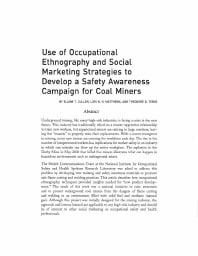Mining Publication: Use of Occupational Ethnography and Social Marketing Strategies to Develop a Safety Awareness Campaign for Coal Miners
Original creation date: December 2008
Authors: ET Cullen, LN Matthews, TD Teske
Underground mining, like many high-risk industries, is facing a crisis in the near future. This industry has traditionally relied on a master-apprentice relationship to train new workers, but experienced miners are retiring in large numbers, leaving few "masters" to properly train their replacements. With a recent resurgence in mining, many new miners are entering the workforce each day. The rise in the number of inexperienced workers has implications for worker safety in an industry in which one mistake can blow up the entire workplace. The explosion in the Darby Mine in May 2006 that killed five miners illustrates what can happen in hazardous environments such as underground mines. The Health Communications Team at the National Institute for Occupational Safety and Health Spokane Research Laboratory was asked to address this problem by developing new training and safety awareness materials to promote safe flame cutting and welding practices. This article describes how occupational ethnographic techniques provided insights needed for "new product development." The result of this work was a national initiative to raise awareness and to protect underground coal miners from the dangers of flame cutting and welding in an environment filled with solid fuel and methane (natural gas). Although this project was initially designed for the mining industry, the approach and lessons learned are applicable to any high-risk industry and should be of interest to other social marketing or occupational safety and health professionals.

- Determining the Root Causes of Flame Cutting and Welding Fires in Underground U.S. Coal Mines
- Escape From Farmington No. 9: An Oral History
- Guidelines for the Development of a New Miner Training Curriculum
- Historical Development of Technologies for Controlling Methane in Underground Coal Mines
- Progress Toward Improved Engineering of Seals and Sealed Areas of Coal Mines
- Reducing the Fire and Explosion Hazards of Flame-Cutting and Welding in Underground Coal Mines
- Refuge Alternatives in Underground Coal Mines
- Rock Dusting Considerations in Underground Coal Mines
- Technology News 535 - NIOSH Releases New Educational Video: Escape from Farmington No. 9: An Oral History
- Wireless Mesh Mine Communication System